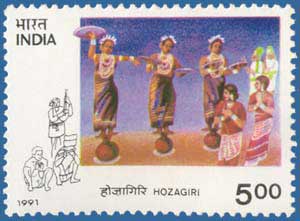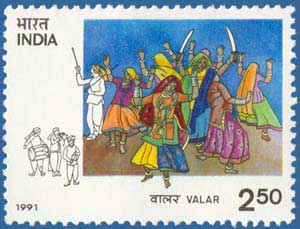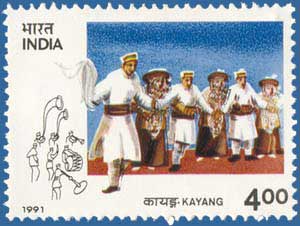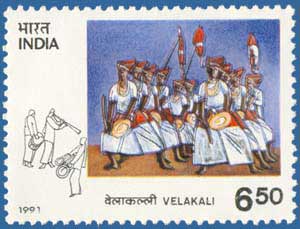Tribal Dances on Indian Stamps
The hinterland of India is inhabited by various tribes. These tribes have traditions of centuries behind them and have made rich contributions to the country's history and culture. Despite the onset of civilisation and the pressure of modernisation, the tribals have, to a large extent, maintained their distinct identity, customs and mores. Their characteristic dances form an important and colourful part of their traditions and customs. To highlight and to recognise the contribution of tribal dances to India's culture, a set of four stamps on Tribal Dances is being issued.
A symbolic representation of the various dances of the tribes spread throughout the length and breadth of; the country is made through the dances particular to four regions situated in the distant corners of the country. The tribal dances presented in this set represent the Reangs of Tripura in the East, the Garasias of Rajasthan in the West, the Kinners of Himachal Pradesh in the North and the Kundividians and the Nairs of Kerala in the South.
Reangs |
 |
For the Reangs, dance is almost a part of their daily life. To the accompaniment of drums, flutes and stringed instruments, the Reang women standing on earthen pitchers rhythmically twist the lower part of their bodies while at the same time balancing and waving metal plates on their hands. In the colourful costumes worn by them in this dance, the most conspicuous items are jewellery; necklaces, of beads and silver coupled with dominant display of flowers in their hair.
Valar |
 |
Valar is the typical dance of Garasias. Its song is woven round the beauties of nature; starry nights, moonlight, mountains and restless rivers. It is an expression of romantic feelings rendered in a lyrical mood. Artistically, the dance is highly developed and seeks to establish correlation between word, sound and gesture. The dance is characterised by colourful costumes and silver jewellery.
Kayang |
 |
Kayang is a popular dance form of Kinnaur. It is a rosary dance in which the artists hold hands in a cross form that look like the beads of a rosary. The male dancers take their positions one after the other alternatively. The leader of the party carries a whisk in his hand and starts the dance. This form of dance is both thrilling and heart-warming.
Velakali |
 |
Velakali dance is predominantly performed by Kundividians and Nairs. Each dancer holds a shield in one hand and a stick in the other. The dancers wear a white dhoti on which a red cloth sash is tied. The headdress is a flaming red turban with a border of gold. It is performed to the accompaniment of trumpets, kettledrums and war cries. Basically it is a martial dance full of dramatic situations depicting the victory of the Pandavas over the Kauravas. It is marked by fast movements, jumps and turns.
Date of Issue : 30.4.1991
No comments:
Post a Comment